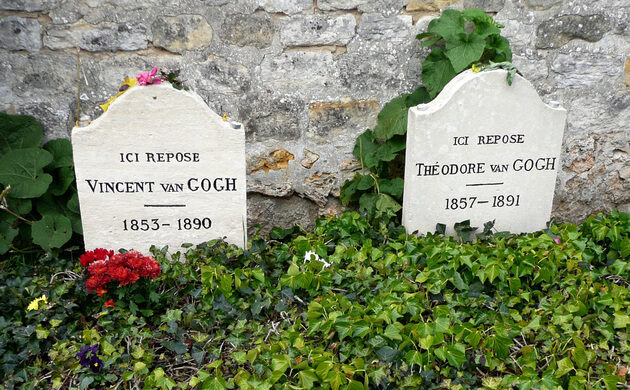For Van Gogh


lately, I’ve wondered
about that final canvas
the one that disappeared
from the wheat field
probably at the same
moment
you blacked out, in shock
after the pea shooter
bullet lodged there next
to your spine
was it another wheat field
with the sky so black
that you couldn’t see the
crows
couldn’t see the wind
through the spikes
with the spikes
disappearing
swallowed by the dark
was it starry night again
except as a vision of the
trajectory
of the bullet, blood cells
wearing
halos as they rush to
spill from the wound
was it blank, a white
light
canvas, the same blank
as all those brain synapse
flashing violent
simultaneous
seizing
then
nothing
was it the future
Theo raving in guilt and
madness
in a Utrecht asylum, or
both
of your graves, ici repose
on a heath in Auvers
or was it a last self-portrait
you in Theo’s arms
your spirit rushing out
in swirls impasto
spelling
I want to die like this


Theo van Gogh and Self-Portrait -- Vincent van Gogh
Vincent van Gogh's 1887 portrait of his younger brother Theodorus was believed to be a self-portrait until a closer examination revealed that its subject had rounder ears, a lighter beard, and shaved cheeks. They were the sons of Dutch Reformed Church minister Theodorus van Gogh. Vincent was born in 1853 and named after a brother stillborn exactly a year before his own birth, as well as his grandfather who had 3 sons who became art dealers, a great uncle who had been a sculptor, and an uncle who was a partner in the influential Goupil & Cie art dealership in Paris. Theo was born in 1857. In 1869 uncle Vincent obtained a position for Vincent at Der Haag branch of his firm and was transferred to London in 1873, the same year Theo was hired in the Bruxelles office; Vincent was transferred to Paris in 1875 but, unhappy with the commodification of art, was dismissed in 1876. Like his brother, Theo was also transferred to London, then moved to Der Haag and became a successful art dealer and by 1884 was in Paris, where he was responsible for his firm's purchase and exhibition of works by Claude Monet and Edgar Degas. In 1886, Theo invited Vincent to live with him in Paris, where he introduced him to Paul Gauguin, Paul Cézanne, Henri de Toulouse-Lautrec, Henri Rousseau, Camille Pissarro, and Georges Seurat. After Vincent moved to Arles, Theo persuaded Gauguin to join him there in 1888. The 2 artists quarrelled, Vincent mutilated his ear (perhaps after threatening Gauguin); after recovering from his wound, Vincent was hospitalized at the Saint-Paul-de-Mausole asylum. About that time Theo met Johanna Bonger in Amsterdam. Though Theo barely knew her he became infatuated and proposed marriage; she rejected him, but after a year's courtship they wed in 1889; their son (also Vincent) was born on 31 January 1890. In May 1890 Vincent left the clinic and moved to Auvers-sur-Oise, where he was treated by Paul Gachet, a physician who painted (as "Paul van Ryssel"), wrote art criticism (as "Blanche de Mézin"), was a friend of Pissarro and Cézanne, oversaw Auguste Renoir's recovery from pneumonia in 1882, and in 1883 advised Édouard Manet not to have his left leg amputated. (Manet did not follow this advice and died 11 days after the operation.) On 8 June Theo's family visited Vincent, who refused to cut back on smoking and drinking. On 27 July, in a wheat field where he was painting, he shot himself in the chest. The bullet was deflected by a rib, passed through his chest, and was stopped by his spine without damaging any internal organs. He walked back home and was attended to by 2 doctors, but there was no surgeon available to remove the bullet. He died on 29 July, at 37; his last words were, "The sadness will last forever." Theo, who was suffering from dementia paralytica, a brain infection, depressed over his brother's fate, was admitted to the Willem Arntz psychiatric hospital in Den Dolder on 18 November and died on 25 January 1891 at 33. He was survived by his wife Jo, who had about 200 of Vincent's unsold paintings in her home, and little else. She opened a boarding house in Bussum, a village 25 km from Amsterdam, and began to establish her brother-in-law's reputation and to collect and publish his extensive correspondence with Theo. In 1914, she moved Theo's body from Utrecht and interred it next to Vincent's grave in Auvers-sur-Oise. A sprig of ivy taken from the garden of Dr Gachet carpets both graves.
ReplyDeleteExcellent poem, and an outstanding tribute to a timeless artist, I dig it.
ReplyDelete